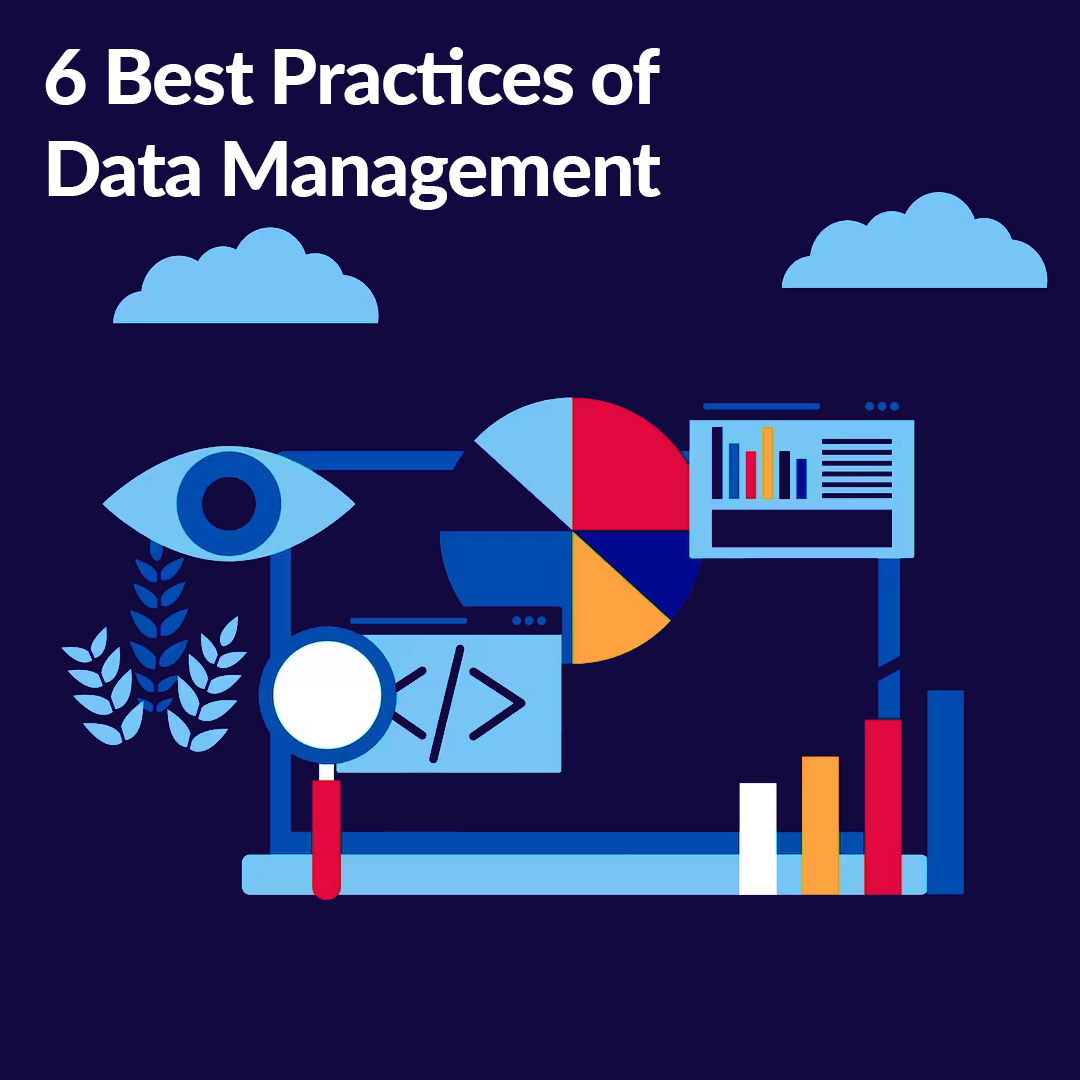6 Data Management Best Practices to Improve Data Performance
By ensuring the availability of quality information, data management empowers organizations to elevate their decision-making, streamline operations, and reduce costs. However, given the array of options and data management strategies available, embarking on this journey can be daunting.

“The global master data management market is set to experience significant growth in the coming years, with a projected CAGR of 15.7% from 2022 to 2027. Starting at a value of $16.7 billion, the market is anticipated to reach a substantial valuation of $34.5 billion by the conclusion of 2027.”- Markets And Markets
What Is Data Management?
Data management encompasses the comprehensive process of organizing, storing, and overseeing data throughout its entire lifecycle. It involves various activities such as data integration, processing, and analysis. The primary objective of data management is to maximize the value of data by ensuring its quality, consistency, and security at every stage. Effective data governance is crucial, involving the establishment of policies and procedures to ensure data accuracy, integrity, and compliance with regulatory standards. This entails defining data standards, assigning roles and responsibilities, and implementing data quality controls.
Data storage and backup are also integral aspects of data management. Organizations must employ suitable data storage services and solutions to securely store and preserve data for future use, which could include on-premises storage systems, cloud-based storage, or a hybrid approach. Furthermore, data analytics play a pivotal role in data management. Leveraging various analytical methods and tools, organizations can derive valuable insights from their data, facilitating informed decision-making and the identification of patterns and trends.
Importance of Data Management
- Well-managed data is easily discoverable and accessible to users. It’s organized in catalogues or folders, simplifying data retrieval for anyone needing access.
- Effective data management enhances credibility by ensuring data reliability and source authenticity.
- Data management is vital within organizations as it oversees data throughout its entire lifecycle.
- Managed data provides valuable insights that guide business growth strategies, enabling informed decision-making.
Further Read: Why Businesses Need a Powerful Data Strategy? 6 Ultimate Reasons
Top 6 Data Management Best Practices
Keeping an efficient data management process within an organization and ensuring that data is handled effectively and securely throughout its lifecycle requires the application of the following essential good data management practices.
 1. Set Data Quality Standard
1. Set Data Quality Standard
Establishing a robust data quality standard is of utmost importance in today’s business landscape. It serves as the foundation for evaluating the suitability and value of different datasets from various perspectives. Both business leaders and users must actively participate in ensuring their data requirements are met and promptly addressing any data quality issues that arise. High-quality data is the cornerstone of effective business intelligence and well-informed decision-making in the corporate world. To gauge whether data aligns with its intended purposes, companies rely on key data quality metrics, including accuracy, relevance, completeness, reliability, accessibility, and consistency across diverse data sources. Data quality serves as the primary driving force behind comprehensive data management initiatives undertaken by organizations. It underscores the essential need to maintain data of the highest caliber, upholding the integrity and efficacy of data-driven processes.
2. Define Master Data & Metadata
Metadata and master data are integral facets of data management for ensuring data integrity and categorization. Metadata such as data originators, data types within a dataset, field descriptions, the context in which data was generated, its intended purpose, and the methodologies employed in its creation. On the other hand, master data represents a critical subset of data, focusing on core business entities like customers, products, and suppliers. It defines the foundational elements that drive an organization’s operations and decision-making. Accurate and well-maintained master data is crucial for harmonizing data across an enterprise, eliminating redundancies, and ensuring consistency. Metadata and master data collectively play a pivotal role in creating a secure and efficient data governance framework. Metadata guides data lineage, facilitating data tracking from source to destination, while master data underpins core business processes, enabling accurate and consistent operations. Together, they empower organizations to harness the full potential of their data assets, making informed decisions and optimizing their business strategies for the long term.
3. Design a Flexible & Scalable Data Architecture
Designing a flexible and scalable data architecture is pivotal in modern data management, allowing organizations to effectively adapt to evolving data needs. According to a survey, 87% of organizations have low data and analytics maturity, highlighting the need for robust data architectures. A flexible data architecture accommodates various data sources and formats, ensuring seamless data integration. It promotes agility by enabling quick adjustments to accommodate new data types and volumes. Scalability, on the other hand, ensures that your data infrastructure can grow as your business expands. To achieve this, organizations should consider modern data storage solutions like cloud-based data lakes and warehouses. Implementing data virtualization and containerization technologies enhances agility. Employing microservices and APIs further fosters scalability. Incorporating metadata management and data governance within the architecture enhances data quality and compliance.
4. Prioritize Data Protection & Security
Prioritizing data protection and security is paramount in fostering a culture of data security and maintaining trust with stakeholders. To establish a solid foundation, organizations must adhere to high privacy standards and implement security protocols at every level. Compliance with regulations like HIPAA, CIPA, GDPR, and others is crucial, with recurring audits ensuring ongoing adherence. Effective data protection includes comprehensive backup plans, and safeguarding data against potential loss or breaches. While traditional models necessitated local and remote data copies, modern cloud-based solutions offer decentralized data duplication at lower costs. Moreover, organizations should invest in educating their staff on data privacy importance and maintaining secure networks.
5. Establish Data Access Control
88% of data breaches involve the unauthorized access of data, highlighting the significance of robust access controls. Establishing robust data access control plays a crucial role in safeguarding sensitive information. Data access control involves implementing security measures to restrict access to data based on user roles, responsibilities, and the principle of least privilege. This means ensuring that individuals can only access the data necessary for their specific job functions. To achieve this, organizations should employ technologies like identity and access management (IAM) systems, encryption, and multi-factor authentication (MFA). Additionally, regular monitoring and auditing of data access permissions are essential to identify and mitigate potential security risks. By establishing stringent data access controls, organizations can significantly reduce the risk of data breaches and maintain data integrity.
6. Data Governance – (Auditing & Compliance)
Data governance is a cornerstone of effective data management best practices. It encompasses the establishment of policies, procedures, and standards to ensure data quality, security, and compliance with regulations. Auditing, a key component of data governance, involves regular assessments of data processes and practices to identify and rectify issues. It ensures data accuracy and reliability. Moreover, compliance adherence is critical in today’s regulatory landscape. Data governance ensures that organizations meet legal requirements such as GDPR, HIPAA, or industry-specific regulations. This not only mitigates legal data management risks but also fosters trust among customers and stakeholders. By embracing master data governance practices, organizations can enhance data transparency, minimize data management risks, and drive data-driven decision-making with confidence.
Further Read: Data Strategy Roadmap for the Growth of Your Business
Data Management Risks & Challenges
In today’s data-rich landscape, managing data comes with substantial challenges. The ever-growing volumes of data, ranging from structured to semi-structured and unstructured, create complexities. Inefficient data architectures and isolated systems make integration and administration difficult, leading to issues with data reliability and consistency across various platforms. Even well-planned setups struggle to provide data scientists and analysts with seamless access to relevant data, especially when it’s spread across multiple databases and big data systems.
To address these challenges, many data management teams are turning to data catalogues. These catalogues include information listings, business dictionaries, metadata-driven data dictionaries, and data lineage records, all aimed at improving data accessibility. However, the rapid transition to the cloud brings both opportunities and challenges. Moving from on-premises systems to cloud databases can be intricate, with cost management becoming a top concern. It’s crucial to monitor and control cloud system expenses to prevent budget overruns. Therefore, while the cloud offers numerous advantages, organizations must navigate these new complexities effectively to maximize its benefits.
Conclusion
The era of data management has ushered in transformative opportunities for businesses across diverse industries. To harness the full potential of this data-driven landscape, organizations must follow data management best practices. It is the linchpin that ensures data remains an asset, facilitating real-time decision-making, maintaining competitiveness, and enhancing customer engagement. At “NextGen Invent”, we understand the critical importance of effective data management. Our data management services empower businesses to implement the data processing best practices.
Having a trusted technology partner like NextGen Invent can mitigate the risks and challenges. Contact us today and embark on a journey to unlock the true potential of your data.
Stay In the Know
Get Latest updates and industry insights every month.
 1. Set Data Quality Standard
1. Set Data Quality Standard